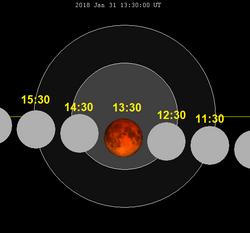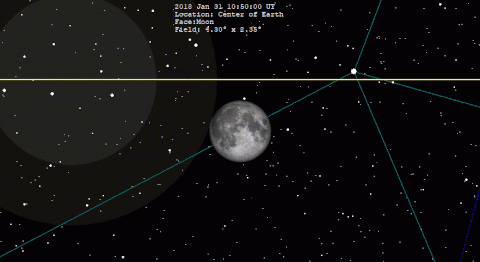January 2018 lunar eclipse
| Total lunar eclipse January 31, 2018 | |
|---|---|
Ecliptic north up The moon will pass west to east (right to left) through the Earth's shadow. | |
| Saros (and member) | 124 (49 of 74) |
| Gamma | -0.3014 |
| Duration (hr:mn:sc) | |
| Totality | 1:16:04 |
| Partial | 3:22:44 |
| Penumbral | 5:17:12 |
| Contacts (UTC) | |
| P1 | 10:51:15 |
| U1 | 11:48:27 |
| U2 | 12:51:47 |
| Greatest | 13:29:50 |
| U3 | 14:07:51 |
| U4 | 15:11:11 |
| P4 | 16:08:27 |
A total lunar eclipse will take place on January 31, 2018. The moon appears as supermoon, with perigee being on January 30. Additionally it is the first blue moon eclipse in 2018.
Background
A lunar eclipse occurs when the Moon passes within Earth's umbra (shadow). As the eclipse begins, Earth's shadow first darkens the Moon slightly. Then, the shadow begins to "cover" part of the Moon, turning it a dark red-brown color (typically – the color can vary based on atmospheric conditions). The Moon appears to be reddish because of Rayleigh scattering (the same effect that causes sunsets to appear reddish) and the refraction of that light by Earth's atmosphere into its umbra.[1]
The following simulation shows the approximate appearance of the Moon passing through Earth's shadow. The northern portion of the Moon is closest to the center of the shadow, making it darkest, and most red in appearance.
Overview
Visibility
The Pacific Ocean will be turned toward the moon at the time of the eclipse. Central and eastern Asia (including most of Siberia), Indonesia, New Zealand and most of Australia will get a fine view of this moon show in the evening sky. Heading farther west into western Asia, the Indian subcontinent, the Middle East and Eastern Europe, the eclipse will already be underway as the moon rises.[2]
 View of earth from moon during greatest eclipse |
 Visibility map |
Timing
| Eclipse | HST | AKST | PST | MST | CST | EST | UTC | IST |
|---|---|---|---|---|---|---|---|---|
| Zone from UTC | -10h | -9h | -8h | -7h | -6h | -5h | 0h | +530h |
| Penumbral eclipse begins | 12:51 | 1:51 | 2:51 | 3:51 | 4:51 | 5:51 | 10:51 | 16:21 |
| Partial eclipse begins | 1:48 | 2:48 | 3:48 | 4:48 | 5:48 | 6:48 | 11:58 | 17:28 |
| Total eclipse begins | 2:52 | 3:52 | 4:52 | 5:52 | 6:52 | ---- | 12:52 | 18:22 |
| Mid-eclipse | 3:30 | 4:30 | 5:30 | 6:30 | ---- | ---- | 13:30 | 19:00 |
| Total eclipse ends | 4:08 | 5:08 | 6:08 | 7:08 | ---- | ---- | 14:08 | 19:38 |
| Partial eclipse ends | 5:11 | 6:11 | 7:11 | ---- | ---- | ---- | 15:11 | 20:11 |
| Penumbral eclipse end | 6:08 | 7:08 | ---- | ---- | ---- | ---- | 16:08 | 21:38 |
Along the U.S. West Coast, the total phase begins at 4:51 a.m. PST. The farther east you go, the closer the start of the partial phases will coincide with moonrise. Along the U.S. Atlantic Seaboard, for instance, the moon will have only just begun to enter the darkest part of Earth's shadow, the umbra, at 6:48 a.m. EST when it will disappear from view below the west-northwest horizon. The duration of the total phase is 77 minutes, with the moon tracking through the southern part of the Earth's shadow. So, during totality, the moon's lower limb will appear much brighter than the dark upper limb.[3]
Related eclipses
The January 2018 lunar eclipse the first ascending node eclipse of the Lunar eclipse series sets from 2016–2020. It is also part of Saros cycle 124.
| Lunar eclipse series sets from 2016–2020 | ||||||||
|---|---|---|---|---|---|---|---|---|
| Descending node | Ascending node | |||||||
| Saros | Date | Type Viewing |
Gamma | Saros | Date Viewing |
Type Chart |
Gamma | |
| 109 | 2016 Aug 18
|
Penumbral
|
1.56406 | 114
|
2017 Feb 11
|
Penumbral
|
−1.02548 | |
119
|
2017 Aug 07
|
Partial
|
0.86690 | 124
|
2018 Jan 31
|
Total
|
−0.30143 | |
129
|
2018 Jul 27
|
Total
|
0.11681 | 134
|
2019 Jan 21
|
Total
|
0.36842 | |
139
|
2019 Jul 16
|
Partial
|
−0.64300 | 144
|
2020 Jan 10
|
Penumbral
|
1.07270 | |
| 149 | 2020 Jul 05
|
Penumbral
|
−1.36387 | |||||
| Last set | 2016 Sep 16 | Last set | 2016 Mar 23 | |||||
| Next set | 2020 Jun 05 | Next set | 2020 Nov 30 | |||||
See also
References
- ^ Fred Espenak; Jean Meeus. "Visual Appearance of Lunar Eclipses". NASA. Retrieved April 13, 2014.
{{cite web}}: Unknown parameter|last-author-amp=ignored (|name-list-style=suggested) (help) - ^ "First Blue Moon Total Lunar Eclipse in 150 Years Coming This Month". Space.com. Retrieved 2018-01-02.
- ^ "First Blue Moon Total Lunar Eclipse in 150 Years Coming This Month". Space.com. Retrieved 2018-01-02.
External links
- 2018 Jan 31 chart: Eclipse Predictions by Fred Espenak, NASA/GSFC
- Hermit eclipse: 2018-01-31
- LunarEclipse2018.org


